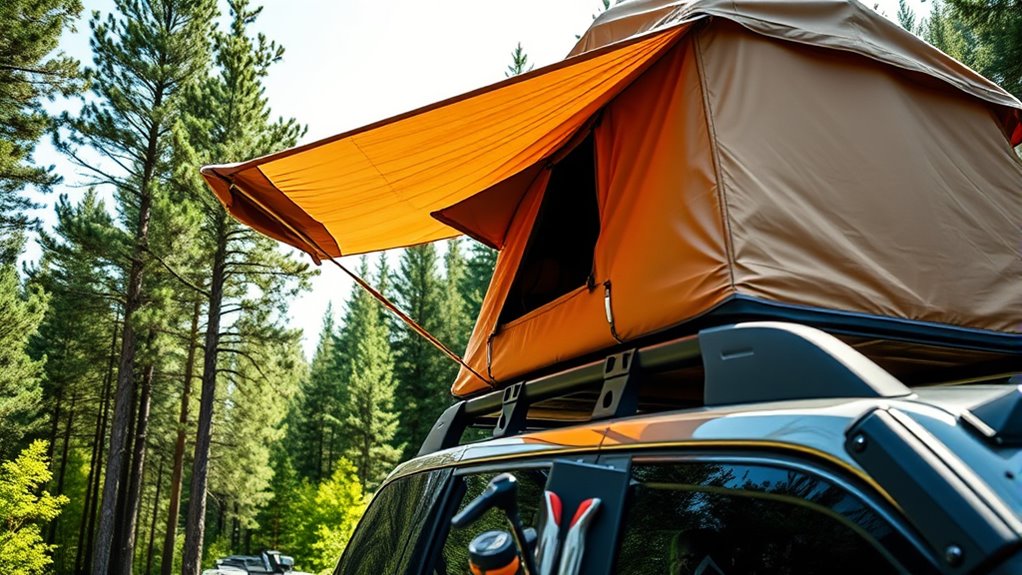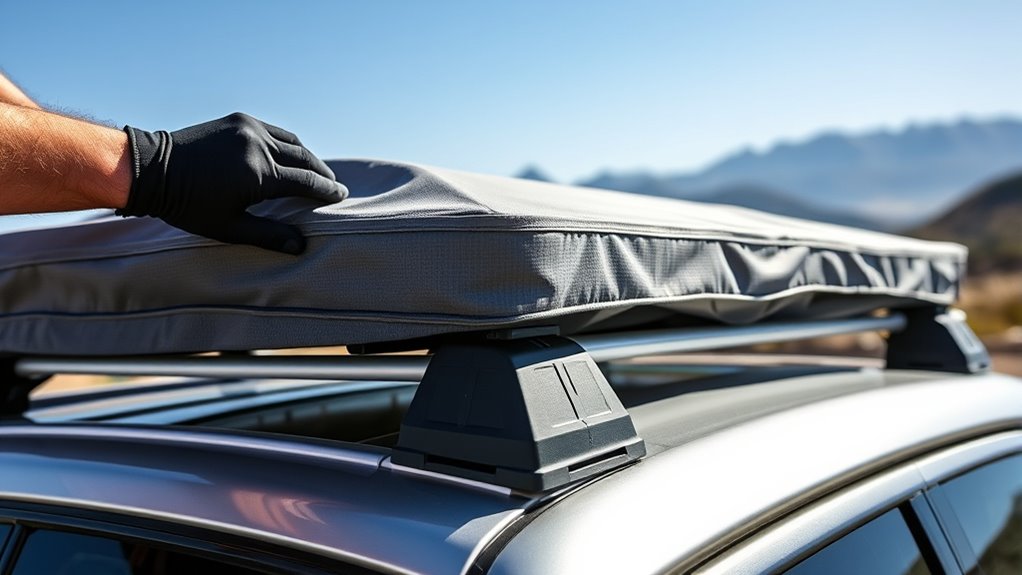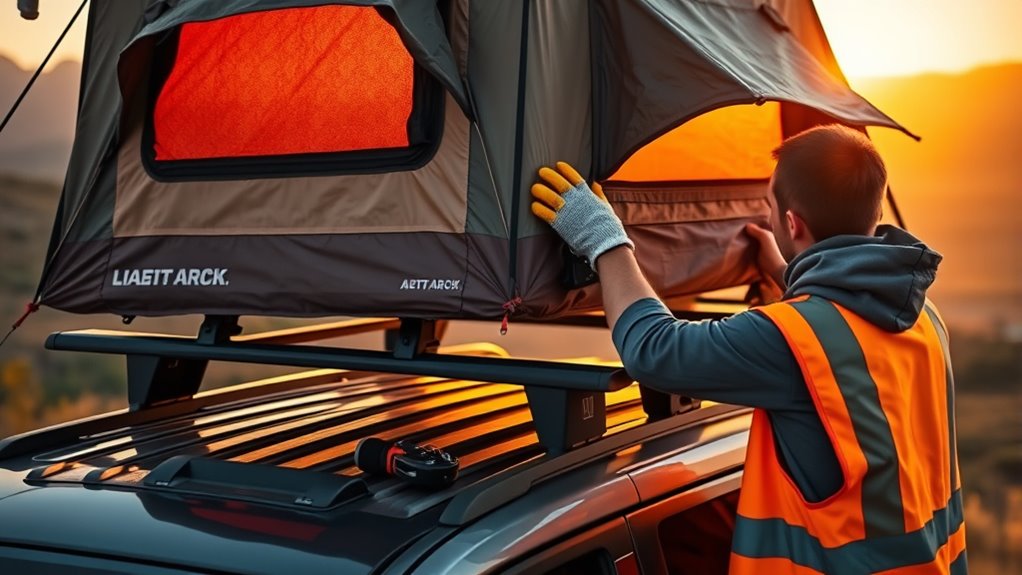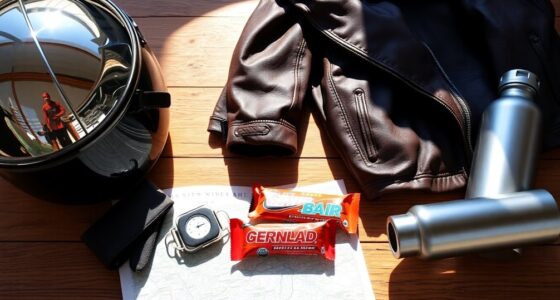To install a rooftop tent, start by inspecting your vehicle’s roof rack for weight support and securing it properly. Next, position the tent base evenly on the rack, ensuring it’s centered and level according to the manufacturer’s instructions. Attach the tent to the crossbars using the provided brackets or straps, tightening everything securely. Check all fasteners and supports for stability, then prepare the tent’s interior for use. Keep going to discover detailed tips for a safe, hassle-free setup.
Key Takeaways
- Inspect and prepare your vehicle’s roof rack for weight capacity and secure mounting.
- Position the tent base evenly on the roof rack, ensuring it is level and centered.
- Attach the tent to crossbars or roof rack using brackets, straps, or clamps as per manufacturer instructions.
- Tighten all fasteners evenly, check stability, and verify weight distribution before use.
- Perform safety checks, secure all zippers and locks, and ensure proper ventilation for comfort.
Preparing Your Vehicle and Equipment

Before installing a rooftop tent, it is vital to prepare your vehicle and gather all necessary equipment. Start by inspecting your roof rack to verify it can support the tent’s weight and is securely mounted. Check the condition of your vehicle’s roof to prevent leaks or damage. Consider adding tent insulation to improve comfort in varying climates. Weatherproofing techniques, like sealing seams and applying protective coatings, help keep water out and maintain a dry interior. Gather essential tools such as a wrench, screwdriver, and ladder. Make sure you have all hardware and straps needed for installation. Proper preparation minimizes surprises during setup, guaranteeing your rooftop tent stays secure and weather-resistant, ready for your adventure. Additionally, understanding digital literacy can enhance your knowledge of online safety and maintenance tips for your equipment. It’s also helpful to review weight capacity guidelines to ensure your roof rack can safely support the added load. Moreover, familiarizing yourself with installation instructions provided by the manufacturer can streamline the process and prevent errors. Being aware of vehicle compatibility ensures that your vehicle can safely accommodate the rooftop tent without risking damage or instability. To further support your setup, checking the rental or purchase options for necessary accessories can save time and ensure you have everything needed for a smooth installation.
Positioning and Securing the Tent Base

Once your vehicle and equipment are ready, focus on properly positioning the tent base. Start by aligning the mounting hardware with your roof rack or crossbars, ensuring the base sits level and centered. Proper positioning helps maintain balanced weight distribution, which is essential for safe driving and preventing damage to your roof. Double-check that the tent base is evenly spread across the mounting points, avoiding overhangs or uneven weight loads. Secure the base tightly using the appropriate hardware, tightening bolts or clamps as specified by the manufacturer. Take your time to confirm everything is square and stable before proceeding. Proper positioning and securing of the tent base lay a solid foundation for a safe and comfortable rooftop camping experience. Additionally, understanding self-watering plant pots and their benefits can be helpful for ensuring your plants thrive with minimal maintenance during your adventures.
Attaching the Tent to the Roof Rack or Crossbars

Attaching the tent to the roof rack or crossbars requires careful alignment and secure fastening to guarantee stability during your trip. First, check the tent’s weight to ensure your roof rack or crossbars can support it safely. Confirm crossbar compatibility by verifying that your bars are rated for the tent’s weight and have the right width and height. Position the tent so that its mounting points align with the crossbars, then use the provided brackets or straps to secure it tightly. Tighten all fasteners evenly, avoiding overtightening that could damage the tent or rack. Proper attachment prevents shifting or swaying while driving, ensuring safety and stability throughout your journey. Double-check all connections before hitting the road. Additionally, understanding roof rack capacity can help you avoid overloading and ensure a secure setup. Being aware of weight distribution ensures that the load is balanced properly, reducing stress on the roof components and enhancing safety. Moreover, consulting the manufacturer’s instructions can provide specific guidance for your particular tent model to ensure proper installation.
Ensuring Stability and Safety Checks

To guarantee your rooftop tent remains stable and safe during your trip, thoroughly inspect all attachment points and fasteners after installation. Check that the weight distribution is even across the roof rack or crossbars to prevent undue stress. Ensure the tent is securely fastened and that all bolts and straps are tight. Consider weather conditions; if rain or wind is expected, double-check that the tent’s anchors can handle these elements. Look for any signs of wear or damage on mounting hardware, and verify the integrity of the roof rack system. Properly balanced weight and secure fastenings minimize the risk of accidents. Additionally, inspecting the roof rack system ensures it can support the combined weight of the tent and occupants safely. Regularly perform these safety checks during your trip to maintain stability and peace of mind on the road, especially considering that secure fastening is crucial for preventing accidents. Incorporating these practices aligns with farmhouse decor inspirations that emphasize safety and harmony in outdoor setups.
Final Setup and Ready-to-Use Tips

After completing your safety checks and confirming the stability of your rooftop tent, it’s time to prepare it for use. Start by inspecting the tent material for any tears or damage, ensuring it’s clean and dry. Properly set up the ventilation features to maximize airflow and reduce condensation, especially on warmer nights. Adjust the windows and vents to promote cross-ventilation and keep the interior comfortable. Before sleeping, secure all zippers and closures to prevent drafts or insects from entering. Pack any necessary accessories, like a mattress or bedding, inside the tent. Double-check that all locking mechanisms are engaged for safety. Incorporating proper air circulation techniques can also enhance comfort and authenticity. Using the correct anchoring methods ensures the tent remains stable during windy conditions. Ensuring the tent is properly anchored and secured can prevent accidents during windy conditions. Additionally, consider headphone compatibility to enjoy your favorite music or podcasts while relaxing inside the tent. With these steps, your rooftop tent will be ready for a comfortable and secure outdoor experience.
Frequently Asked Questions
How Do I Choose the Right Rooftop Tent for My Vehicle?
When choosing the right rooftop tent, you need to take into account vehicle compatibility first, making sure it fits your roof rack and weight limits. Look at tent materials; durable, weather-resistant fabrics like polyester or acrylic will stand up better over time. Also, think about your camping style—do you want quick setup or extra comfort? Picking a tent suited to your vehicle and needs ensures a hassle-free adventure and long-lasting use.
What Tools Are Necessary for Installation?
You’ll need basic tools like a socket wrench, screwdrivers, and possibly a drill for installation safety. Tools needed vary based on your vehicle and tent model, so check the instructions carefully. Ensuring you have the right tools helps prevent accidents and makes the process smoother. Always double-check that your tools are in good condition, wear safety gear, and follow manufacturer guidelines for a secure, safe rooftop tent installation.
How Do I Maintain and Clean the Rooftop Tent?
To maintain and clean your rooftop tent, regularly inspect the fabric for dirt or damage and gently clean it with mild soap and water. Keep the tent waterproofing intact by reapplying a waterproofing treatment when needed, especially after cleaning. Make sure to dry the fabric thoroughly before storing it to prevent mold. Proper care prolongs your tent’s lifespan and ensures it remains weatherproof for your adventures.
Can I Install the Tent Alone or Do I Need Assistance?
You can definitely attempt a solo installation of your rooftop tent, but assistance is often helpful, especially for lifting and securing the tent properly. If you have a sturdy roof rack and the right tools, you might manage alone. However, having someone to hold the tent steady or help align it can make the process safer and easier. Assess your strength and the tent’s weight before deciding if assistance is needed.
What Are Common Mistakes to Avoid During Installation?
Avoid alliteration and accidental aggravation by attentively addressing installation errors and safety hazards. During setup, double-check mounting brackets and hardware to prevent potential pitfalls, and never overlook safety protocols. Rushing can lead to mistakes like misaligned tent placement or loose fittings, creating safety hazards. Stay focused, follow instructions carefully, and avoid shortcuts to guarantee a secure, safe, and smooth installation experience.
Conclusion
Once you’ve followed these steps, you’re all set for adventure. Imagine waking up to a sunrise in the mountains, feeling completely at ease knowing your tent is secure. Like Sarah, who confidently installed her rooftop tent alone and enjoyed her first night under the stars — it’s moments like these that make all the effort worth it. With your new setup, endless memories await just beyond your doorstep. Happy camping!









